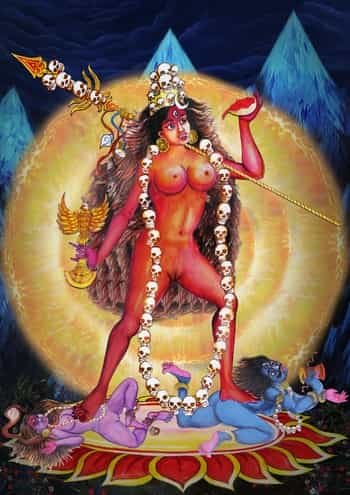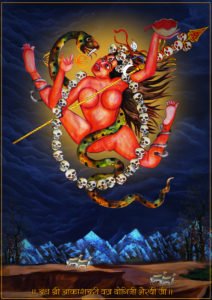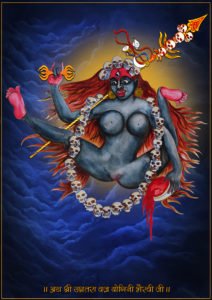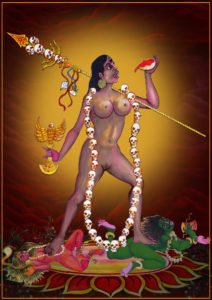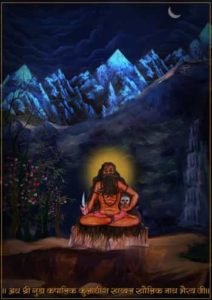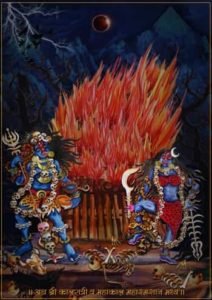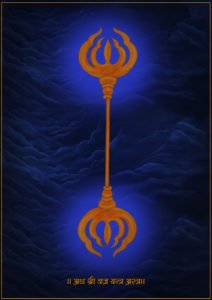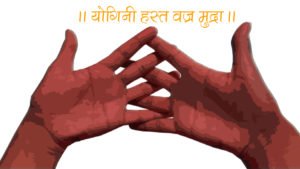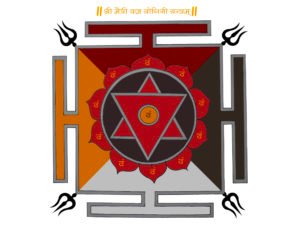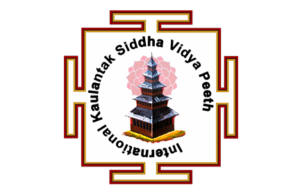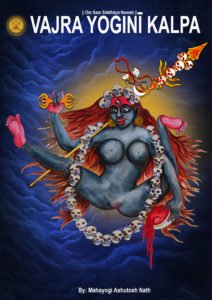Vajra Yogini (Sanskrit: Vajrayoginī, Devanagari:वज्र योगिनी)is the tantric goddess of the Siddhas. The original but often hidden name of Vajra Yogini is Vajrika. In her Mandala and Loka, she is without her male counterpart but her male consort is Maha Vajra who is invisible in her Mandala. Although by nature she resembles a Dakini, but because of her self experience during her manifestation she became known as a Yogini. She embodies qualities of Yoga, Aghora and Vama traditions. In her iconography she is often shown boldly flaunting all the ‘tamas’ tattva qualities . She is in fact the goddess of the ‘Tamas’. Her path is all about the path of ‘Tamas’ to achieve the transcendental state of beyond all qualities and Gunas (Siddha Chitta Avastha). Vajra Yogini is the supreme Goddess who takes a practitioner to the Siddha Chitta of perfect awareness. This she does without denying various passions. She is fierce in boldly accepting various Rasas and passions of life, including the Tamasic and dark desires.
Without discrimination of moral and immoral, right and wrong, Satvik or Tamasic, Vajra Yogini is the favourite Goddess of Siddhas who take her practitioners to the supreme state of great awareness of Siddha Chitta. Vajra Yogini who is also called as Siddha Matri, is the supreme Dakini who is the essence of all Siddhas.
Often her bold Dakini form terrifies ignorant people. Vajra Yogini is the Ishta Devi of Gupta Yoginī Kula, Guptatara Yoginī Kula, Parā Yoginī Kula and Aparā Yoginī Kula. In many traditions, Vajra Yogini is shown as the goddess who symbolizes the tantric path to perfection of ‘Vajra nadi’.
As per ‘Siddha Dharma’, Vajra has different meanings. Primarily, Vajra means super strong. Secondly, Vajra means the backbone. As per the legends of ‘Siddha Dharma’, the ‘Vajra Weapon’ of Indra was made from the backbone of Maharishi Dadhichi who was a Siddha practitioner of Vajra Yoga. Dadhichi Rishi upon the request of Devas willingly left his body so that his bones could be made a vajra weapon to subdue the Daityas. Thirdly, Vajra is also called diamond. The diamond represents luster and longevity. Fourthly, Vajra also represents Vajra Nadi which the the subtler Nadi that the subtle Sushumna Nadi.
Yogini is the female counterpart of Yogakash.
Etymology
Etymologically, ‘Vajra Yogini’ is made up of two words Vajra (वज्र) and Yogini (योगिनी). She manifested from tamasic Shakti of Kaal Ratri from her navel and the root chakra with Vajra diamond that Kaal Bhairava revealed in his spine to his consort Kaal Ratri. Since she manifested in the extreme Tamasic environment of Maha Cremation ground, she became the favourite Goddess of all those practitioners who want to achieve the state of transcendence through the Tamas and dark qualities.
As per ‘Siddha Dharma’, she is the goddess perfected only through ‘miscrachara’. She is the path of the tamas to yoga so ‘Siddha Dharma’ never prescribes only tantra for her worship. Yoga is by nature ‘rajasic’ and the infusion of Yoga into her practice only cultivates those needed ‘tamas’ for the betterment of sadhaka’s spiritual journey. Her tantra infused with Yoga is solely done by Mahasiddhas to restrict ‘Tamas’ to the acceptable standards.
Iconography
As per ‘Siddha Dharma’, Vajrayogini and her various manifestations are depicted to be on top of open petalled lotus flower. This signifies that despite her fierce appearance, she is a goddess who bestows bliss, peace and progress to her worshipers. The wide space inside the lotus is called ‘Anant Aakash’ which signifies infinity and infinite possibilities in the universe. The petals around it implies the artforms.
Goddesses are depicted in nude. But she is not in human nude form who is wandering in the cosmos. Nudity here implies the truth. Her head is embellished with half moon which symbolizes her natural truth, inner peace, love and completeness. Her skull necklace signifies the Varna Beej and Tantrik sounds.
She is carry a Khatvang weapon on her shoulder which represents her ruling over universe by transcending the three gunas. It also represents great capability (Maha Samarthya), courage (Veerta), glory (Saurya) and spontaneous bold judgement (Maha Saahas).
“Khatvaang is also symbolic of Saumya Maha Danda. This means that she metes out justice in a way that her punishments do not seem like punishments. One does not notice that he or she is being punished but suffers greatly through that punishment.
She is wearing a divine crown made of five skulls which represents the five elements and also hints at the presence of Devi inside the five sheaths of human body or Pancha Koshas (Annamaya, Pranamaya, Manomaya, Vigyanmaya & Anandmaya).
Vajra Yogini holds a skull bowl in her hand which is called Akshay Patra or Anand Patra. This symbolizes that she manifests the whole creation and is dissolving it all by consuming it. She is shown to be unaffected by these acts of creation and dissolution.
Origin of Vajra Yogini
Many people are born with Tamasic qualities. They are naturally drawn towards all things that society holds as Taboo or immoral. Dharma practitioners started to ostracise these Tamasic people saying they have no right to practice Dharma or they can never become Siddhas. This ostracised group of Tamasic people kept on increasing. They, despite their immoral ways and natural inclination towards taboos still wanted to practice Dharma. Rishis and Siddhas petitioned Swacchanda Bhairava to find a way so that such Tamasic people can also attain Siddhahood despite their negative and tamasic ways.
On request of Rishis and later on the leela of Maa Kurukulla inquiring about Tamas, prompted Swacchanda Bhairav Shiv to form Vaam Maarg and Aghora path for attaining the supreme Siddha hood by incorporating Tamas qualities in path of spiritual practices. This path was driven further by Vajra Yogini who manifested from the Tamasic forms of Swacchanda Bhairav and Maa Kurukulla of Kaal Bhairav and Kaal Ratri.
Vajra Yogini Traditions
Lord Shiva gave the knowledge on Vajra Yogini Rahasya Vidya to Nandi, Bhrigu, Vishvamitra, Vashistha, Shukracharya, Deva Raaj Indra and Vishnu. Alongside them, Maha Siddha Matsyendra Nath and Maha Kapalik Khabbal Khaulika also received this knowledge.
Skanda (Kartikeya) is the main Acharya of the hidden (Gupta) tradition of Vajra Yoga which came from Vajra Yogini. Rishika Gandha Dhyuti obtained Vajra Yogini Vidya from Maa Kurukulla and started her own tradition called Guhya Dhyuti Vajra Kula.
There have been many Siddhas and Rishis who obtained this knowledge but few have made significant contribution to take the Vajra Yogini tradition forward.
Apsara Urvashi who obtained knowledge on Vajra Yogini from Deva Raaj Indra in Swarga, started her Kula called Naṭa Kāmikā Vajra Kula.
Krittikā Traya, the three Krittikās learned Vajra Yogini Vidya from Maha Muni Kashyap who obtained it from Shakta tradition of Maa Kurukulla. Krittika Traya started the Traya Sādhana Vajra Kula.
From Vishvamitra and Vashisth, Rishis, Siddhas and Gurukul tradition obtained Vajra Yogini Rahasya Vidya.
From Shukracharya the tradition of Vajra Yogini went to Daityas and Danavas. Three Rishis, Sambuddha, Prabuddha and Maha Buddha of a tradition named Sthool Kula, even though they were Rishis of one of the Nastika Kula of Brihaspati, learnt about Vajra Yogini Rahasya from the tradition of Shukracharya. They established Vajra Samaya Kula. This lineage in medieval times spanned into many smaller Vajra Kulas and Samaja. But by this time the knowledge on Vajra Yogini got corrupted and got associated with many smaller deities, gurus and avataras. Until the medieval times, knowledge on Vajra Yogini was seldom written down in completeness. It was during the medieval times that there was a race to codify knowledge on Vajra Yogini from different sources. But this created even more confusion as people wrote volumes on Vajra Yogini with only partial and often misguided information.
Origin of Vajrayāna
Originally Vajra Yāna was called as Vajra Ayana or Vajraāyana. Vajra means diamond, thunderbolt or backbone and Ayana means time or era. Originally, Vajra Ayana meant the time of Vajra. This indicated the illuminated enlightened moment more precious and having greater strength than rare diamonds.
This tradition due to vernacular usage became known as Vajra Yāna and its symbolic meaning also changed to the Vehicle (Yāna) of Vajra.
Siddha Dharma says that to show Kāla Ratri her form as Kula Kundalini Shakti in Kāla Bhairava, Kāla Bhairava stripped his skin and flesh to show his backbone which had seven Vajra diamonds shinning extremely bright. When the piercing brightness of the Vajra Diamonds on Kāla Bhairava’s backbone blinded the Rishis and Siddhas who were witnessing this Leela, then the Rishis pleaded Mahākāla to save them from this piercing light which even bothered their inner vision. Then Hevajra manifested from Mahākāla and saved the Rishis from this trouble.
Forms of Vajra Yoginī
As per Siddha Dharma, the seven Vajra diamonds on body of Kāla Bhairava manifested seven Goddesses. These seven Goddesses are the manifestation of Vajrika Shakti and because of their direct manifestations before other forms of Vajra Yogini they are considered primary emanations of Vajra Yogini.
1) Taditā Vajra Yoginis
Seven Taditā Vajra Yoginis who manifested directly from the Vajra of Kāla Bhairava :
- Vajra Yakshini in the Muladhara (root) vajra point
- Vajra Kāmīnī in the Swadhisthana vajra point
- Vajra Bhairavī in the Manipura vajra point
- Vajra Yoginī in the Anahada vajra point
- Vajra Gandhā in the Visuddha vajra point
- Vajra Nayikā in the Agya chakra vajra point
- Vajra Kubjikā in the Sahasrar vajra point
Apart from them, ten other Goddesses manifested from Vajra Yogini who established ten different Vajra Kula.
2) Kāmada Vajra Yoginis
Ten Kāmada Vajra Yoginis who manifested from the heart of Maha Vajra Yogini:
- Maitri Vajra Yoginī – Guhya Maitri Vajra Kula
- Nīla Vajra Yoginī – GuhyaNīla Vajra Kula
- Kākākśī Vajra Yoginī – GuhyaKākākśī Vajra Kula
- Vidyā Dharī Vajra Yoginī- GuhyaVidyā Dharī Vajra Kula
- Ākāshcarī Vajra Yoginī- Guhya Ākāshcarī Vajra Kula
- Vairocanī Vajra Yoginī- GuhyaVairocanī Vajra Kula
- Nara Khechari Vajra Yoginī – GuhyaNara Khechari Vajra Kula
- Indra Khechari Vajra Yoginī – Guhya Indra Khechari Vajra Kula
- Agni Vajra Yoginī – Guhya Agni Vajra Kula
- Ugra Tarā Yoginī – Guhya Ugra Tarā Vajra Kula
3) Mekhalā Vajra Yoginis
Twenty two Mekhalā Vajra Yoginis who manifested from the navel centre of Maha Vajra Yoginis:
- Trilokya Langhini Vajra Yoginī
- Vīlra Vajra Vajra Yoginī
- Rakta Pravāhi Vajra Yoginī
- Swetāngi Vajra Yoginī
- Kurma Patni Vajra Yoginī
- Mada Vilāsā Vajra Yoginī
- Guhya Vajra Vilāsā Vajra Yoginī
- Trikālā Vajra Yoginī
- Kavacha Kīlā Vajra Yoginī
- Kaumarya Yāminī Vajra Yoginī
- Pashu Mukhi Vajra Yoginī
- Sambhogodyatā Vajra Yoginī
- Guhya Prasāda Vajra Yoginī
- Siddhā Vajra Yoginī
- Indra Kāmā Vajra Yoginī
- Naṭa Kāma Vajra Yoginī
- Vaṁkāri Vajra Yoginī
- Māyā Kautukā Vajra Yoginī
- Shunya Dehā Vajra Yoginī
- Vārāha Mukhī Vajra Yoginī
- Padma Langhinī Vajra Yoginī
- Tattvārthini Vajra Yoginī
These Mekhalā Vajra Yoginis are the primordial Goddesses who moves all the emotions and passions in the universe. Vāma Marga says all emotions one feels exists in the universe and from there it flows through all.
4.Mochanā Vajra Yoginis
Mochanā Vajra Yoginis manifested from the feet of Maha Vajra Yogini.
Mochanā Vajra Yogini are the Goddesses of Aghora. They represent negative emotions. negative Tattvas and all aspects of life that ideally should be left aside, including poisonous and Kriya (destructive) tattvas in the universe. They are:
- Yama Mātri Vajra Yoginī
- Acalā Vajra Yoginī
- Dahati Vajra Yoginī
- Yama Damstri Vajra Yoginī
- Ullūkākśī Vajra Yoginī
- Guhyottamā Vajra Yoginī
- Yama Dyutī Vajra Yoginī
- Yama Mathanī Vajra Yoginī
5. Priśṭhikā Vajra Yoginis
Priśṭhikā Vajra Yoginis manifested from the the backside of Maha Vajra Yogini.
They are:
- Khadira Vāṇī Vajra Yoginī
- Nairāmyā Vajra Yoginī
- Ardha Paryankā Vajra Yoginī
- Svānākśī Vajra Yoginī
- Sukrākśī Vajra Yoginī
- Vāyu Vegā Vajra Yoginī
- Druma Chāyā Vajra Yoginī
- Sura Bhakśī Vajra Yoginī
- Aerāvatī Vajra Yoginī
- Pandara Vāsinī Vajra Yoginī
- Mahā Viryā Vajra Yoginī
- Canḍākṣī Vajra Yoginī
- Kharbarī Vajra Yoginī
- Heyakaraṇā Vajra Yoginī
- Khagānanā Vajra Yoginī
- Cakra Vegā Vajra Yoginī
- Capalā Vajra Yoginī
- Niharikā Vajra Yoginī
- Yāmalā Vajra Yoginī
- Shvākā Vajra Yoginī
- BāDa Vajra Vajra Yoginī
- Vajra Carcikā Vajra Yoginī
- Vajra Gauri Vajra Yoginī
- Vajra Varṇanī Vajra Yoginī
Avatāra of Vajra Yogini
At the request of Swacchanda Bhairava (Shiva), Vajra Yogini took three avataras. These avataras started their own traditions. Even though they are avatara of Vajra Yogini, their tradition, rituals, mantras are distinctly different from Vajra Yogini. These three avataras are not included in Vajra Yogini Kalpa. These three avataras have their own Kalpa.
- Vajra Vārāhī
- Vajra Vairocanī
- Vajra Kāmā
Vajra Yogini and Vajra Loka
As per ‘Siddha Dharma’ when seven shaktis arose from the body of Kala Bhairava and they rose to the sky, Devi then asked him about the whereabouts of the seven shaktis. He then explained to her that the seven shaktis had risen from his body and went into the universe. The seven goddesses then resided within the close proximity of each other and their enclosed area became Vajra Loka.
Vajra Yoga
Vajra Yoga does not have seven chakra concept but emphasizes on only three chakras. In Vajra Yoga, chakras are primarily called Vajra Vayu Sthala. Muladhar Chakra, Swadhisthan Chakra and Manipura Chakra are referered with Naabhi Mula. Anahata Chakra and Vishuddha Chakra is Hridaya Mula and Agya Chakra and Sahastra Chakra is Trinetra Mula.
The most important experiment in Vajra Yoga is Vajra Vayu Dharana. In this holding the breath inside one does specific visualizations.
Vajroli Kriyas are also derived from Vajra Yoga.
Siddhas who know Vajra Vayu Chalana Kriya are able to transform their bodies into Vajra like strong bodies.
In Vajra Yoga, one emphasises a lot on Lalana Chakra which is a Upa Chakra or Laghu Chakra situated between Agya Chakra & Sahasrar Chakra. Vajra Nadi is also emphasised in Vajra Yoga.
Special meditation on light and flames of lamps are also important part of Vajra Yoga.
Antaha Karana Shravan (observing inner sounds and activities) , focus on five senses and Prakriti Shravan (Observing nature around you and becoming engrossed in it) and studying various mental states and states of nature are all aspects of Vajra Yoga.
Vajra Mudra
There are thirty five kinds of Mudras. These include Dehik Vajra Mudra which includes Vajra Yoga Mudra, Hasta Vajra Mudra and Kaam Vajra Mudra. Combining selection of Vajra Mudras from these constitute Vajra Kriya.
Vajra Mandala
Since the onset of Kaliyuga, the whole universe has been infected by ‘Kali Sankraman’. To protect all the Siddhas living in Lokas (multiverse), Vajra Yoginis created a parallel universe where all the Siddhas and Mahasiddhas reside with their physical or ethereal body. Access to his universe is restricted by Vajra Yogini.
Padmasambhava & Vajra Yogini
Maha Siddha Padmasambhava even after leaving Kulluta Mandala on behest of Guru Mandala, did not leave his Ishta Devi Vajra Yogini but promoted her practices in a new version that he created in BhoTa Desha and Nepal.
His love and devotion for Vajra Yogini prompted him to establish her in his newly formed tradition. Even now, most of his iconography reveal his original practice of being a Maha Kapalika. This is the reason behind his angry demeanour. Also, he is represented as holding the Khatvanga and sometimes Trishula revealing his Vajra Yogini practices and his Shaiva Siddha tradition.
Matsyendra Nath & Vajra Yogini
Mahasiddha Matsyendra Nath received the knowledge on Vajra Yogini from Swacchanda Bhairava (Shiv) on Kailash. Maha Matsyendra Nath is the main Maha Siddha who has explained Vajra Yogini Darshana (Philosphy) in greatest detail. Kaulantak Peeth also received the philosophy of Vajra Yogini from him. Matsyendra Nath gave this knowledge to Kaaminis of Kaam Rupa, Assam. Due to this knowledge, Kaaminis became self ruled and indenpendent and strong. He also gave this knowledge in Swat Valley, Myanmar, Bhutan, Assam, Himachal, Nepal, Tibet and China to various Siddhas.
This darshana of Matysendra Nath, Maha Siddha Ishaputra(HH Mahayogi Satyendra Nath Ji Maharaj ) received this empowerment from his guru Mahasiddha Siddha Siddhanta Nath Ji Maharaj.
Khabbal Khaulika & Vajra Yogini
The third tradition is that of Mahaguru Devguru Brihaspati Nath. He was an ardent follower of agama and nigama and a great devotee of Lord Shiva. He was initiated directly into this wisdom from Shiva and Shakti. Out of his twelve forms, the tamasik Brihaspatis extensively practiced it and propagated it. It was also one of the tamasic forms of Brihaspati Nath who initiated Maha Kapalik Khabbal Khaulika Nath into the Vajra Yogini empowerment.
Maha Kapalik Khabbal Khaulika Nath was one of the prominent practitioners of Vajra Yogini sadhana. He received the Vajra Yogini empowerment from Devaguru Brihaspati Nath himself. When he perfected it, he later initiated many kapalikas into the wisdom of Vajra Yogini. The Kapaliks then empowered many siddhas of Kaulantak Peeth and many siddhas got initiated into it through guru-disciple lineage.
As per ‘Siddha Dharma’, Khabbal Khaulika was born in the Shiva worshipping tradition of forest dwellers of the Himalaya. His father’s one hand was bitten off by leopard so he used to be mocked and bullied in the name of his father. When one day he lost his patience, he went to his mother and enquired with her the cure of her father’s disability to which she replied that the Yoginis who resides in the top of the Himalaya can fix his father’s arm. With strong motive and purpose, he then left his house for the solution of his miseries.
He walked day and night, in the sun and the shade, amidst rivers and creeks for the search of Yoginis in the Himalayan hills and mountains. He then reached a particular place in the deep jungle at the evening time. He was surprised to see all the foods ready and nicely placed for him to consume. Not being swayed away by the temptations, he marched forward. He witnessed many animals on the way but he kept walking and he then reached a valley which was a gorge where the water flowed inside the ground.
He as a small child couldn’t cross the gorge because it was not his play. So he decided to wait for the right time to cross the gorge. Meanwhile he had an unwavering focus upon the Yoginis of the Himalaya. After three days when still no progress had been met, a Yogini out of nowhere witnessed the young boy meditating. She then manifested before him in the form of an ordinary village woman and asked him about his journey. When Khaulika answered her, she tried her best to persuade him to change his mind but she sensed his unwillingness to divulge from his purpose. She then appeared in her original form and told him that he could take him there through the aerial route to which Khabbal Khaulika accepted the proposal.
With the acceptance, the Yogini held his hand and headed towards the mountain top where Yoginis reside. When they reached the top, he was informed that the Yoginis had gone to Mount Kailasa for the darshana of Lord Shiva. He also asked the Yogini the take him to Kailash and in no time the Yogini and him landed in Kailasha. In Kailasha, he witnessed Lord Shiva giving the sacred wisdom of Vajra Yogini to Ma shakti and just in front of him, there was another Mahasiddha who was listening to the whole conversation with unfettering focus about Vajra Yogini. The Mahasiddha was Matsyendra Nath. Both of them listened the sermon with utmost care.
The Yogini then later took him back to the mountain top and handed him an artificial hand and asked him to give it to his father and the moment his father touches it, the hand shall became his original hand. He went to the society and handed it to his father and his father then received a new arm. All were very happy but not Khabbal Khaulika. He sensed that in the midst of all this happenings, his desires for tantric sadhana had skyrocketed therefore he lost interest in this worldly affairs and asked the permission of his parents. The parents accepted his permission and let me choose to pursue his interest.
As per ‘Siddha Dharma’, the first and foremost question before him was the search for his Guru who could empower him in the wisdom and practice of Vajra Yogini. He then went to a deep forest and he practiced sadhana to an extreme. Such extreme was his sadhana that his hair grew so long that it had already became bigger than his height. Oneday, thing took a sudden twist when Brihaspati Nath was passing by and he witnessed Khabbal Khaulika. Devguru then asked to boy to introduce him and the purpose of his sadhana. Khabbal Khaulika replied that he was in search of a guru who could initiate him into the sadhana of Vajra Yogini.
Devaguru Brihaspati Nath then introduced himself and Khabbal Khaulika prostrated before him. Devguru then took him under his tutelage and initiated him into the wisdom of Vajra Yogini. With his relentless pursuit for the perfection of Vajra Yogini, he performed austerity and later he managed to perfect it to such extent that his teachings had more clarity then other Mahasiddhas.
Maha Siddha Ishaputra, founder of Siddha Dharma in Kaulantak Peeth has obtained Yogic, Tantrika, Aghora and Vaamchar rituals of Vajra Yogini from the Guhya Kapaalik Kula of Maha Kapaalik Khabbal Khaulika.
Vajra Yantra (Astra) & Vajra Yogini
In Siddha Dharma, Trishula is Astra (mantrik weapon) of Swacchand Bhairav. Similarly Ma Kurukulla (Aghoreshwari) has Panchashula as her Astra.
When Maha Vajra Yogini manifested her form in expansive glory in the universe, she manifested Vajra Astra from her Panchashula.
In Devi’s Mandala, two Vajraaksha Bhairava established themselves outside her Mandala. To protect the Mandala from the Urdhva Amanaaya (top direction) and Adho Amanaaya(bottom direction), Devi manifested Panchashula in both direction. This gave rise to a unique astra called Vajra Astra.
When Maha Matsyendra Nath did sadhana practices of Vajra Yogini, then Vajra Yogini gave him a Vajra Astra in boon which entered his body through his Anahata Chakra and got embedded in his backbone. This made him immortal.
Since that time, all the Siddhas and Kapalikas in various traditions of Maha Matsyendra Nath started keeping a symbolic Vajra Yantra Astra.
Vajra Yogini and Vamana Avatara
As per ‘Siddha Dharma’, Lord Vishnu did penance to please Vajra Yogini. He obtained the Shakti of Vajra Yogini and became Shakti Purush himself. In his Vaaman Avatara, Lord Vishnu was able to jump through the whole universe in couple of steps because of the boon of Vajra Yogini Trilokya Langhini.
Book on Vajra Yogini
Vajra Yogini Kalpa written by Mahayogi Ashutosh Nath is a reference textbook which is used to teach students in International Siddha Vidya Peeth. This book contains all aspects of Vajra Yogini Darshana, forms, practices and traditions et al.

